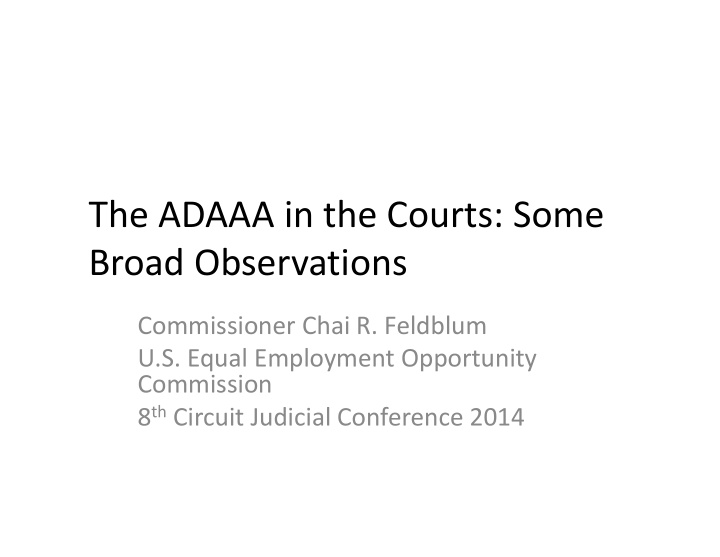



The ADAAA in the Courts: Some Broad Observations Commissioner Chai R. Feldblum U.S. Equal Employment Opportunity Commission 8 th Circuit Judicial Conference 2014
ADAAA • Purposes: (1) Expand and simplify coverage – analysis should be quick and many people should be covered. (2) Overturn restrictive Supreme Court cases – Sutton and Toyota rules no longer applicable.
The Definition of Disability • Disability means “with respect to an individual: (A) a physical or mental impairment that substantially limits one or more major life activities of such individual; (B) a record of such an impairment; or (C) being regarded as having such an impairment” 42 U.S.C. §12102(1).
ADAAA – Specific Changes • Retains the term “substantially limits” but findings and purposes note that it is not a high standard. • Expands list of major life activities and notes that major life activities includes major bodily functions. • Clarifies that conditions should be evaluated in their active state without reference to any mitigating measures (medication, learned habits, etc.).
ADAAA – Specific Changes • Adds a new definition for “regarded as.” – Persons claiming to have been regarded as a person with a disability need only show that they have a physical or mental impairment and were subjected to an act that would be prohibited by the ADA. – Limited exception – impairments that are both transitory AND minor are excluded. – Reasonable accommodation claims not permitted in “regarded as” claims.
ADAAA in the Courts • So far, the courts are applying the law largely as intended. Courts are citing and correctly applying the new EEOC standards.
ADAAA in the Courts • There have been a few hiccups though: (1) some decisions still cite old case law and old standards. (2) many decisions overlook major bodily functions. (3) the new “regarded as” definition has caused confusion, especially the “transitory and minor” exception.
ADAAA in the Courts • In a number of cases, errors were the result of attorneys failing to plead new standards. • EEOC is actively seeking to educate the public and attorneys about rights (see notice of rights on next slide). • EEOC is also actively looking for amicus opportunities to correct any erroneous applications of the law. • Judges may want to be especially alert when hearing ADA claims – consult EEOC regulations and guidance.
ADAAA Notice of Rights Document – available at www.eeoc.gov/laws/types/adaaa_notice_of_rights.cfm
Recommend
More recommend